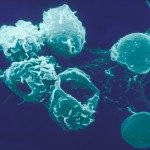Link to Pubmed [PMID] – 22238456
J. Immunol. 2012 Feb;188(4):1600-8
How T cell progenitors engage into the γδ or αβ T cell lineages is a matter of intense debate. In this study, we analyzed the differentiation potential of single thymocytes from wild-type and TCRγδ-transgenic mice at two sequential early developmental stages. Double-negative (DN) 3 progenitors from both wild-type and transgenic mice retain the capacity to engage into both pathways, indicating that full commitment is only completed after this stage. More importantly, DN2 and DN3 progenitors from TCRγδ transgenic mice have strong biases for opposite fates, indicating that developmentally regulated changes, other than the production of a functional TCR, altered their likelihood to become a γδ or an αβ T cell. Thus, unlike the differentiation in other hematopoietic lineages, T cell progenitors did not restrict, but rather switch their differentiation potential as they developed.



